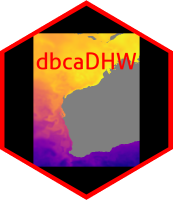
Introduction
The intention behind this package is to share how we went about creating some useful SST data that was used in the Global Change Biology journal paper, “Too hot to handle: Unprecedented seagrass death driven by marine heatwave in a World Heritage Area”.
The functions and workflow suited the particular data and modelling needs presented in the paper and as such probably won’t be directly transferable to other data sets. However it should provide some ideas and all code can be examined in the package GitHub repo.
Functions used in this package will:
convert global SST data sets into more manageable img formatted cropped versions (defaults to the Western Australian region).
based on a user provided area of interest, create vector shape files based on the geometry of the SST data.
extract daily SST values and export them to csv file for further analysis.
Lastly, the articles Making metrics and Degree heating weeks will show how to use the exported data to create useful SST metrics.
Installation
You can install the development version from GitHub with:
# install.packages("devtools")
devtools::install_github("dbca-wa/dbcaDHW")
library(dbcaDHW)Data
The functions were designed to be used on NOAA’s Coral Reef Watch SST data. The data is daily sea surface temperatures (SST) in netcdf format (nc).
Folder Structure
A working directory or R Studio project needs to be determined. The
downloaded data and any user supplied shape files should be stored here.
Below, a processing folder called sst_processing/ is being
used to demonstrate.
The downloaded data should be stored in a directory called
nc_data/ and within that the data is further organised by
year directories. This example shows only the first 4 days of 1985 and
1986. Also present in the working directory is a region of interest
(optional) and an area of interest shape file (required) and these will
be discussed further.
Any outputs created by the functions will end up in the working directory.
Workflow
Step 1
Firstly the downloaded data needs to be saved to img format. This
format works well with GIS software and is also easier to handle if
cropped to a smaller area. The nc_to_img function below
defaults to cropping the outputs to a Western Australian region but the
user can supply their own if desired. The below example uses the working
directory and region of interest as described above.
# user supplied region of interest
nc_to_img(pathin = "X:/DATA/SST/CRW/sst_processing", vector = "region_of_interest_WGS84")
# default WA region omit the vector parameter
nc_to_img(pathin = "X:/DATA/SST/CRW/sst_processing")User supplied shape files can have any coordinate reference system as
the function will transform to EPSG 3577 (Australian Albers) prior to
cropping. When supplying the layer name do not include the suffix.
Output img files will be saved in the working directory to a folder
called img_data/ and will be organised by year. They will
also have an EPSG of 3577.
Step 2
The function create_vectors will then create 2 new
vector files. The user will need to supply an area of interest to
further narrow the focus. The output vector files will be created from
the geometry of the img raster data. An extraction vector will be
created from the centroids of the SST pixels that fall within the area
of interest. A cell boundaries vector (based on the pixel boundaries)
will also be generated. Whilst not used in any processing here it can be
useful for visualisation.
Both output vector files have an EPSG of 3577 and are also attributed with a common 4 digit site number. Again, the coordinate reference system of the input vector, the area of interest shape file, doesn’t matter.
# user supplied area of interest
create_vectors(pathin = "X:/DATA/SST/CRW/sst_processing", aoi = "area_of_interest_WGS84")Step 3
The last stage is to use the function extract_daily to
extract the SST values using the extraction vector that was just
made.
# extract daily SST
extract_daily(pathin = "X:/DATA/SST/CRW/sst_processing")All SST values are then compiled and output to csv file.
The working directory should now look like the below. Note there is now a directory tree with img data as well as two new vectors and the csv of SST results.